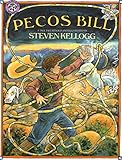Lesson 3: Exaggeration
Lesson Plan
Pecos Bill | 910L

- Learning Goal
- Identify examples of exaggeration in a tall tale.
- Explain that exaggeration is a characteristic of tall tales.
- Duration
- Approximately 50 minutes
- Necessary Materials
-
Provided: Unit Example Chart, Independent Practice Worksheet
Not Provided: Pecos Bill by Steven Kellogg, chart paper, markers
-
Teacher Modeling

will explain that tall tales are called tall tales because they are exaggerated (they are taller, bigger, and more ridiculous than regular stories). Exaggeration means to make something seem more than it actually is. I will add “exaggeration” to my Characteristics of Tall Tales Chart that I started in Lesson 1 (example provided). Say, "For example, if I said, 'The principal’s hands are so big, he could wrap them around the entire school,' I would be exaggerating how big his hands are to tell you that they were really big. Tall tales usually use exaggeration to make the traits and actions of the story’s hero seem bigger and more exciting." I will use the familiar tall tale, Paul Bunyan, to model how to identify exaggeration in a story. I will look for descriptions of actions or people that seem impossible and bigger than life. For example, I will recall that Paul Bunyan combed his beard with a pine tree. Most people only comb their hair with a hair brush. Since I have identified exaggeration in the book, I will add the title to my chart, along with the example of exaggeration I identified.
-
Think Check
Ask: "How can I identify examples of exaggeration in a tall tale?" Students should respond by saying that you can identify exaggeration by looking for descriptions of actions or people that seem impossible and bigger than life.
-
Guided Practice

will read the tall tale, Pecos Bill by Steven Kellogg, and identify examples of exaggeration in the text. We will discuss how there are multiple examples of exaggeration that help us identify the story as a tall tale, so we will add the title of the book to our chart, along with 1-2 examples of exaggeration we identified.
-
Independent Practice

will identify and illustrate one example of exaggeration from the story. You will share your example and illustration so that it can be added to the class chart and explain how you know this is a tall tale. (Independent Practice Worksheet provided.)
Texts & Materials
Standards Alignment
(To see all of the ReadWorks lessons aligned to your standards, click here.)

